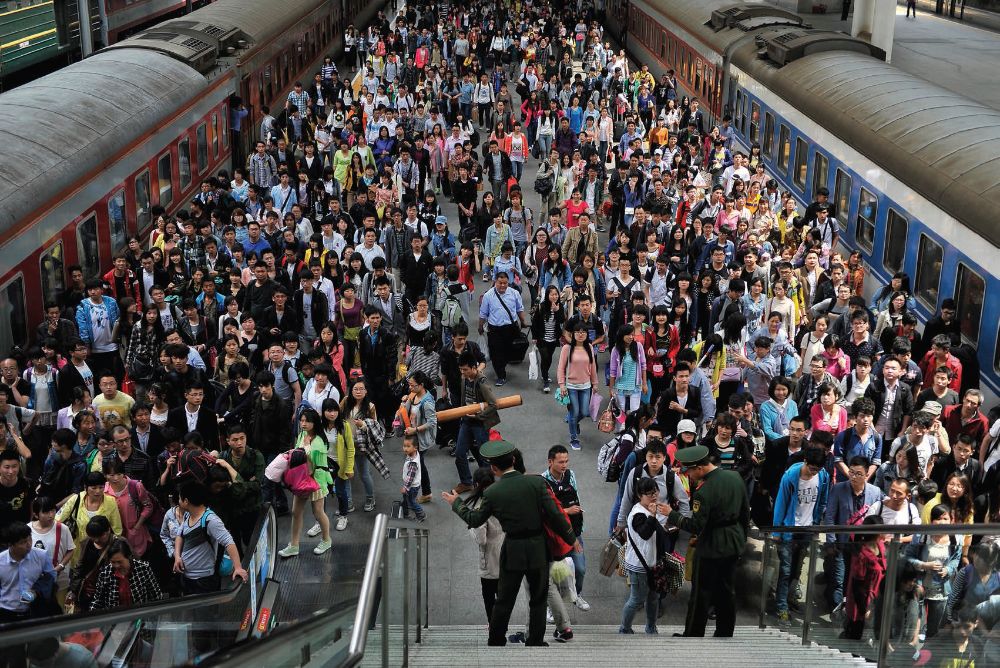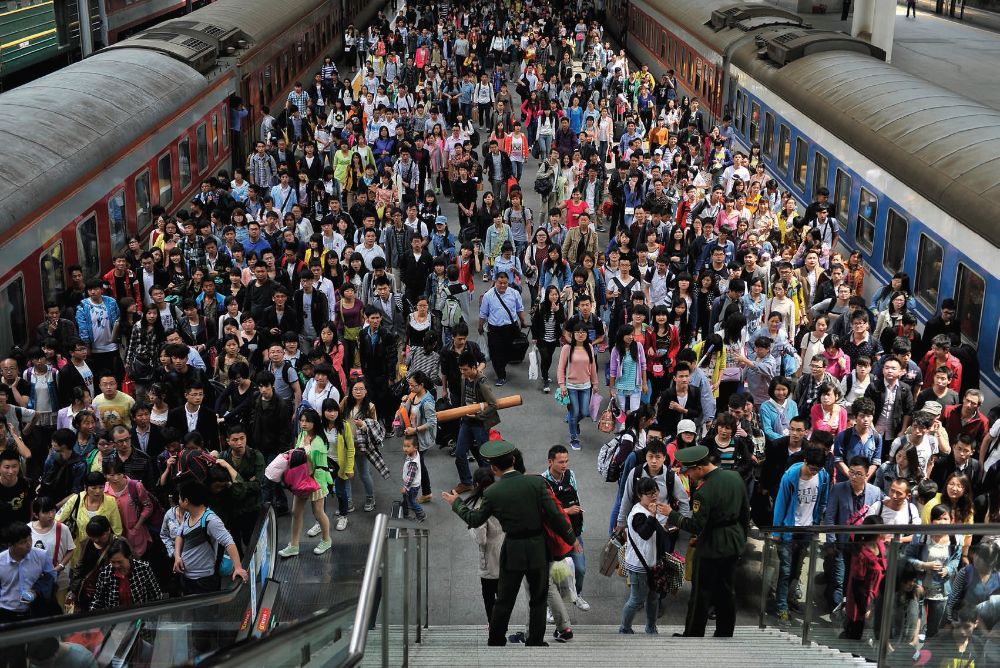
引 言
农业转移人口的市民化,是城乡、区域协调发展重要推动力量,也是我国下一阶段城镇化的重点和难点任务。《中共中央关于制定第十四个五年规划和二〇三五年远景目标的建议》指出,要“推进以人为核心的新型城镇化”,“强化基本公共服务保障,加快农业转移人口市民化”。因此,如何在城市快速有效推进外来务工人员的市民化进程,是政策界和学术界急需回答的问题。然而,对于这一问题的回答,存在两个方面的重要障碍。首先,对于规模已经达到2.9亿人的这一群体,当前社会各界对其了解仍然远远不够。而对这一群体的深入了解,是找到有效的促进市民化的措施的前提。其次,在市民化的进程中,政府、市场和外来务工人员自身,分别应该扮演什么样的角色,仍然需要理论上的梳理。这一问题的关键,又在于市场在市民化过程中的作用往往被忽略。本报告基于对昆山劳动力市场的深入调研,试图从更为全面的视角了解外来务工人员在市民化过程中面临的障碍,并对市场在推进市民化进程中起到的作用及其作用机制进行解析,以期为推进市民化进程的政策和学术研究提供新的信息和视角。作为长三角城市群核心城市之一和全国制造业发展的重镇,和上海、北京、深圳和广州等一线城市类似,昆山也存在大量的“候鸟式”迁徙的劳动者群体。但和一线城市有所不同的是,在城区常住人口500万人口以下城市的落户限制已经有所放松的今天,外来人口在昆山落户在政策上已没有那么困难,从昆山市的户籍人口变化趋势来看,近些年户籍人口有了较大幅度的增长。然而,我们依然可以看到在昆山常住人口数量远远超出户籍人口数量,两者之间的差距近些年来并没有明显地缩小。较为宽松的落户政策、较强的综合经济实力和较小的落户人口规模之间,形成了一个令人困惑的悖论。
从2020年3月份开始,我们与“我的打工网”合作,对昆山市的外来务工人群进行了多次调研。我们发现,户籍制度的制约只是阻碍外来务工者融入城市的第一道障碍。作为“新市民”,他们在就业方式、消费储蓄习惯、身份认同等诸多方面,都存在诸多不利于融入城市的因素。在中国经济进一步集聚的制度性障碍正在经历迅速变革的新的历史阶段,这些非制度因素对于经济集聚的阻碍,及其对外来务工者个人及其家庭造成的福利损失,将是影响中国下一阶段城市化和整体经济发展的非常重要的因素。因此,本报告将借助昆山的案例,来探讨流入人口市民化进程中的障碍以及市场自发产生的缓解之道。
本报告对于昆山市流入人口群体的分析,基于“我的打工网”提供的数据、案例及“新市民产业与创新研究院”积累的关于昆山外来务工者群体市民化过程一些观察。“我的打工网”诞生于2013年8月,由互联网与线下结合一体,成为新兴媒体O2O模式。2014年我的打工网获得创新工场的天使轮融资,其后陆续获得富达基金、诺基亚成长基金、DCM和经纬的私募融资。截至目前接待量超过500万人次,会员量超过100万人,设立集散中心5个,门店8个(分布在昆山、苏州、吴江、上海等地)。2018年度接待超过80万人次。公司采用独特的经纪人模式,为外来务工者提供一条龙服务,关注外来务工者群体从进城找工作开始到融入城市的全过程,并努力促成外来务工者的市民化。新市民产业与创新研究院由“我的打工网”、君灏控股联合复旦大学管理学院中国市场营销研究中心于2019年4月共同成立,其成立的初衷是为了深入研究城市化背景下的新市民群体在工作、生活等多方面状况及存在的问题,并试图找出能够加速其融入城市的措施。

Myths and Realities of China’s Urbanization
Lu Ming
August 2015
Introduction
At the root of China’s many urbanization problems lie a number of misunderstandings about the nature of urbanization at all levels of society. The most common of these misunderstandings are captured in several often-stated assertions: (1) urbanization in China will lead to a reduction of arable land; (2) urban expansion will inevitably mean a deteriorating quality of life, not least because of congestion and pollution; and (3) the costs of comprehensively reforming China’s system of residency permits system (or hukou)—a system that, if reformed, would entitle migrant workers to the full range of public services—will threaten the country’s fiscal sustainability.
Taken together, these three misconceptions have had a powerful impact on government policy in China. Indeed, as a direct result of these deeply held beliefs, Beijing has relied on administrative controls, not market mechanisms, to direct China’s urbanization process.
But such an approach has yielded some major deficiencies in China’s overall urbanization policy. For one thing, Beijing has imposed tight hukou controls on the country’s biggest cities, thus restricting their ability to grow. Second, the Chinese government has relied excessively on administrative power to accelerate urbanization in China’s central and western regions, even though people are, in fact, moving largely to the country’s coastal areas. Third, Beijing has encouraged the development of small and mediumsized cities, but these are usually scattered far away from regional economic centers.
Unfortunately, then, these policies have been economically inefficient, and so they have hindered China’s economic growth momentum in several ways. One way they have held China back is that the extensive growth of China’s central and western regions has resulted in unsustainable levels of local debt. At the same time, the proportion of non-permanent residents in large cities (those who do not have an urban hukou) has continued to rise,exacerbating potential social instability.
Finally, unlike other countries that have experienced rapid urbanization, income disparities between urban and rural areas, as well as between different regions of China, have widened instead of narrowed. This policy memorandum proposes several policy adjustments aimed at mitigating the distorted economic effects of the policies that have flowed from these misunderstandings. Five specific areas of China’s current urbanization policy require changes:
1. China’s hukou system needs dramatic change, not just in the thirdand fourth-tier cities that are the current focus of policy but also in large and very large cities.
2. The allocation of construction land quotas should be consistent with the direction of labor flow.
3. China’s fiscal transfer payment system should be shifted from support for productive investments to support
for public services.
4. Economic growth and tax revenue targets should be deemphasized in the evaluation and promotion system for officials and cadres.
5. China’s large cities should make better use of planning tools in metropolitan areas and urban cores.
Only in this way can cities expand while mitigating urban ills such as congestion and pollution. For instance, through better design of infrastructure and public service provision, China can effectively respond to the challenges that have bedeviled urbanization in other countries.

中国城市化路径的困境与抉择
陆铭
2015年8月
引言
城市化并不是一个简单的提升城市人口比重的问题,它还涉及到城市在不同地区间的分布,而这是形成合理的城市体系的问题。城市体系的合理化必须以生产要素自由流动为前提,以企业自主选址和劳动者自由迁徙为条件,以集聚效应和拥挤效应之间的权衡为机制。于是,具有不同的地理、自然、历史等条件的城市都达到最大化劳动生产率的最优规模,从而形成不同规模、不同功能的城市相互分工、相互依存、共同发展的城市体系。
由于未能科学地认识城市化和城市体系的形成机理,长期以来,政府和社会各界对中国的城市化存在许多误解,主要有:(1)误把耕地减少与城市化简单对应;(2)误把城市病与城市扩张作简单对应;(3)错误地夸大了农民工市民化的成本。受这些认识误区影响,政府倾向于依赖行政手段,而不是市场机制,来指引城市化过程。导致城市化政策和现实情况之间存在大量矛盾。主要有:(1)人口向大城市流动的趋势和大城市户籍制度趋紧的矛盾;(2)人口向沿海城市集聚的趋势和政府行政力量将建设用地指标向中西部配置的矛盾;(3)都市圈集聚发展的趋势和新城、开发区分散发展的矛盾。
由于政策存在误区,导致中国经济增长的动力受阻,效率恶化,地理劣势地区数量型扩张带来的债务负担加重,城乡和地区间收入差距的扩大。同时,大城市内部的非户籍常住人口比重持续上升,社会风险加剧。
针对以上认识和政策的误区,本文提出,在经济政策上,当前中国的城市化需要在五个方面进行政策调整:
1、户籍制度需在大城市和特大城市突破;
2、建设用地指标配置应与劳动力流动方向一致;
3、转移支付制度应从支持生产性投资转向支持公共服务;
4、经济增长和税收应与政府官员的激励和考核脱钩;
5、在大城市人口增长过程中,应注重都市圈和城市内部的科学规划,通过增加基础设施和公共服务的供给,有效应对城市病的挑战。